Jyotiba Temple is a holy site of Hinduism near Wadi Ratnagiri in Kolhapur district of Maharashtra state in western India. The deity of the temple is known by the same name and is a manifestation of Lord Shiva, Lord Vishnu, and Lord Brahma. He is also associated with Surya, the sun god, and Kartikeya, the son of Shiva and Parvati. He is worshipped as the destroyer of demons and the protector of the region.
The temple is situated at a height of 3124 feet above sea level and is dedicated to Jyotiba. The temple is 21 km north-west of Kolhapur and around 65 km from Sangl. According to the tradition, the original Kedareshwar temple was built by Navji Saya. In 1730, Ranoji Shinde of Gwalior renovated the original temple in a grand place. The temple complex consists of several shrines, such as Kedareshwar, Kedareshvar, Ramling, Rameshwari, Satvai, etc.
The temple is famous for its annual fair that takes place on the full moon night of the Hindu months of Chaitra and Vaishakha. Thousands of devotees come with tall sticks (sasan) and scatter red powder (gulal) on the temple premises. The temple and the hill turn pink due to this ritual, resulting in people referring to the temple as the Pink Temple. Visit duering One Day Kolhapur To Jyotiba-Panhala Trip – Visit famous places
Jyotiba Temple is not only a place of worship but also a place of history and culture. The temple has several inscriptions, sculptures, paintings, and veergal stones that depict the legends and events related to Jyotiba and his devotees. The temple also belongs to the Nath sampradaya, a sect of Hinduism that follows the teachings of Guru Gorakhnath.
In this article, we will provide you with some key information about Jyotiba Temple, such as its location, timings, significance, mythology, festivals, etc. We will also give you some tips and suggestions on how to visit the temple and what to expect there.
Table of Contents
Location and Accessibility of Jyotiba Temple:

Jyotiba Temple is located near Wadi Ratnagiri, a village in Kolhapur district of Maharashtra state in western India. The temple is situated on a hilltop at a height of 3124 feet above sea level and offers a panoramic view of the surrounding hills and valleys.
The temple is about 21km north-west of Kolhapur city and around 65 km from Sangli city. The nearest railway stations are Chhatrapati Shahu Maharaj Terminus in Kolhapur and Sangli railway station. The temple can be reached by road from Kolhapur or Sangli by private or public transport. There are buses, taxis, and auto-rickshaws available from these cities to the temple. Alternatively, one can also hire a private cab from any reputed travel agency or service provider for a comfortable and convenient journey.
The temple has a flight of 100 stairs that pilgrims need to climb to reach the main shrine. There are also facilities for parking, accommodation, food, and water available near the temple. However, one should be careful of the monkeys that roam around the temple premises and avoid carrying any food items or valuables with them.
History and Legend of Jyotiba Temple :
Jyotiba Temple has a rich and fascinating history and legend that dates back to ancient times. According to the mythology, Jyotiba is an incarnation of Lord Vishnu, Lord Brahma, and Lord Shiva, who came together to destroy the evil demon Ratnasura, who was terrorizing the region of Kolhapur. Jyotiba also helped Goddess Mahalakshmi, the presiding deity of Kolhapur, in her fight with the demons. He founded his kingdom on the Jyotiba mountain and created twelve Jyotirlingas around it to protect it from evil forces.
According to the legend, Jyotiba was born from the flame that emerged from the hands of Goddess Vimalambuja, who was an incarnation of Goddess Adishakti. She created another set of Tridev (Brahma, Vishnu, and Shiva) who were 100 times more powerful than the original ones to humble their ego. She ordered them to come again when she would call for their help.
When Kolhasura and his army were ruling over Karvir Kshetra (Kolhapur) with unjust methods, Mahalakshmi decided to go back to Karvir and called the Tridev for her help. They appeared in her hands in the form of a flame that took the form of an eight-year-old child bearing a sword, a drum, a trident, and a pot filled with nectar.
The child was named Jyotiba, which means “the radiant one” or “the one who shines”. He also had other names such as Malhari, Malanna, Martanda Bhairava, or Surya. He was also considered as an avatar of Kartikeya (Skanda), the son of Shiva and Parvati. He fought with Ratnasura and his allies and killed them with his weapons. He also helped Mahalakshmi in her battle with the demons and restored peace and prosperity in the region.
The history of Jyotiba Temple is also linked with the history of Kolhapur and the Maratha Empire. The original temple was built by Navji Saya, a devotee from Kival village near Karad. In 1730, Ranoji Shinde of Gwalior renovated the original temple in a grand place. The temple complex consists of several shrines, such as Kedareshwar, Kedareshvar, Ramling, Rameshwari, Satvai, etc.
The temple witnessed several events and developments in the history of Kolhapur and Maharashtra. It was visited by several rulers, saints, and devotees over the centuries. It was also a center of Nath sampradaya, a sect of Hinduism that follows the teachings of Guru Gorakhnath. The temple has several inscriptions, sculptures, paintings, and veergal stones that depict the legends and events related to Jyotiba and his devotees.
Jyotiba Temple is not only a place of worship but also a place of history and culture. It reflects the faith, devotion, and glory of the people who built it and visited it over time. It is one of the most revered places of pilgrimage in Maharashtra that attracts thousands of visitors every year.
Architecture and Design of Jyotiba Temple :
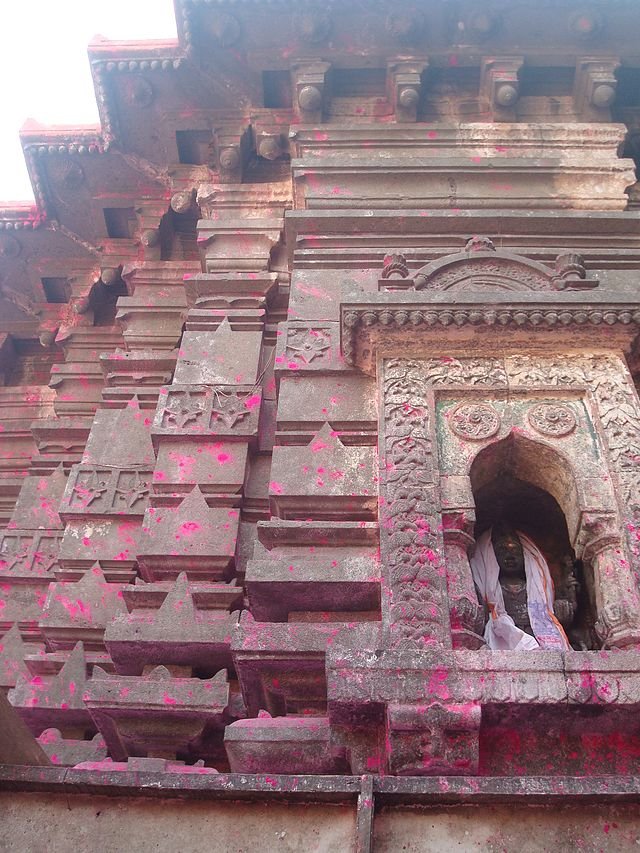
Jyotiba Temple is a remarkable example of the architectural style that evolved around Kolhapur. The temple has a simple and elegant design that reflects the faith and devotion of the people who built it and visited it over time. The temple has several features and details that make it unique and significant in the temple’s cultural and religious context.
The temple complex consists of several shrines, such as Kedareshwar, Kedareshvar, Ramling, Rameshwari, Satvai, etc. The main shrine is dedicated to Jyotiba, who is represented by a four-armed idol that faces south towards Mahalakshmi Temple in Kolhapur. The idol sits on a horse, which symbolizes his association with Surya, the sun god.
The main shrine and the roof spire stand at a massive height of about 57 ft x 37 ft x 77 ft. The shikharas (spires) of the temple are many-faceted and are strengthened by the predominant rathapatta (chariot band), which reaches up to the kalasha (pot). The temple has a magnificent gateway of stone with a strong recessed pointed arch. The walls of the temple are plain and offset to give a feeling of contrast. Small arched openings add to the feeling of massiveness.
The temple also has numerous slender deepmalas (lamp towers), which are typical of Maratha temples. These deepmalas are lit during festivals and special occasions, creating a spectacular sight. The temple also has a flight of 100 stairs that pilgrims need to climb to reach the main shrine. The precinct of the temple is paved and cloisters are constructed on the sides.
The temple also has some unique architectural elements and artistic details that depict the legends and events related to Jyotiba and his devotees. The temple has several inscriptions, sculptures, paintings, and veergal stones (hero stones) that narrate the stories of Jyotiba’s incarnation, his battles with the demons, his miracles, and his devotees’ sacrifices. The temple also belongs to the Nath sampradaya, a sect of Hinduism that follows the teachings of Guru Gorakhnath. The temple has some symbols and motifs that reflect the Nath tradition.
The architecture and design of Jyotiba Temple are not only aesthetically pleasing but also spiritually meaningful. They reflect the glory, devotion, and culture of the people who built it and visited it over time. They also convey the message of Jyotiba’s power, grace, and protection to his devotees.
Best Places to visit in Kolhapur
The Jyotiba Temple: A Famous Cultural and Religious Gem in India
Jyotiba Temple is a holy site of Hinduism near Wadi Ratnagiri in Kolhapur district of…
Panhala Fort: A Historical Treasure in the Western Ghats
Panhala Fort is the largest and most impressive fort in Kolhapur, Maharashtra. Situated in the…
Mahalaxmi Temple- Kolhapur: A Sacred and Ancient Temple
If you are looking for a place to worship and seek blessings from the Goddess…
Rankala Lake, Kolhapur: A Beautiful and Historical Lake
If you are looking for a place to enjoy the beauty and serenity of nature,…
New Palace, Kolhapur: A Royal and Majestic Palace
If you are looking for a place to admire the royal and majestic lifestyle of…
Shalini Palace, Kolhapur: A Heritage and Luxury Palace
If you are looking for a place to experience the heritage and luxury of the…
Religious Significance Of Jyotiba Temple:
Jyotiba Temple is a sacred place of Hinduism that has a high religious significance for the devotees of Jyotiba and the people of Kolhapur and Maharashtra. The temple is dedicated to Jyotiba, who is a manifestation of Lord Shiva, Lord Vishnu, and Lord Brahma. He is also associated with Surya, the sun god, and Kartikeya, the son of Shiva and Parvati. He is worshipped as the destroyer of demons and the protector of the region.
The temple’s deity and religious practices are based on the mythology and history of Jyotiba’s incarnation, his battles with the demons, his miracles, and his devotees’ sacrifices. The idol of Jyotiba is four-armed and faces south towards Mahalakshmi Temple in Kolhapur. He sits on a horse, which symbolizes his association with Surya, the sun god. The idol is adorned with ornaments and clothes by the priests and devotees.
The temple follows the rituals and traditions of Nath sampradaya, a sect of Hinduism that follows the teachings of Guru Gorakhnath. The temple has some symbols and motifs that reflect the Nath tradition. The temple also has some special festivals and ceremonies that attract thousands of visitors every year.
The most famous festival is the annual fair that takes place on the full moon night of the Hindu months of Chaitra and Vaishakha. On this occasion, devotees come with tall sticks (sasan) and scatter red powder (gulal) on the temple premises. The temple and the hill turn pink due to this ritual, resulting in people referring to the temple as the Pink Temple.
Jyotiba Temple is not only a place of worship but also a place of faith and devotion. It represents the power, grace, and protection of Jyotiba to his devotees. It also reflects the local and regional religious traditions and culture of Maharashtra. It is one of the most revered places of pilgrimage in Maharashtra that fulfills the wishes and desires of the devotees who visit it.
Festivals and Celebrations in Jyotiba Temple:

Jyotiba Temple is a place of joy and festivity, where several festivals and celebrations are held throughout the year. The temple attracts thousands of visitors during these occasions, who come to offer prayers, perform rituals, and participate in the customs and traditions of the temple. The festivals and celebrations at the Jyotiba Temple are significant in local and regional cultural traditions.
The most famous festival celebrated at the Jyotiba Temple is the annual fair that takes place on the full moon night of the Hindu months of Chaitra and Vaishakha. This festival is also known as Jyotiba Yatra or Jyotiba Fair. On this occasion, devotees come with tall sticks (sasan) and scatter red powder (gulal) on the temple premises. The temple and the hill turn pink due to this ritual, resulting in people referring to the temple as the Pink Temple. This ritual symbolizes the victory of Jyotiba over the demons and his protection of the region. The festival also includes cultural programs, folk dances, music, and stalls.
Another important festival celebrated at the Jyotiba Temple is Kartik Purnima, which falls on the full moon day of the Hindu month of Kartik. On this day, devotees light lamps (deep) at the temple and offer prayers to Jyotiba. This festival is also known as Dev Deepawali or Festival of Lights of the Gods. It is believed that on this day, Jyotiba blesses his devotees with happiness and prosperity.
Some other festivals celebrated at the Jyotiba Temple are Makar Sankranti, Mahashivaratri, Gudi Padwa, Ram Navami, Hanuman Jayanti, Akshaya Tritiya, Guru Purnima, Nag Panchami, Raksha Bandhan, Janmashtami, Ganesh Chaturthi, Navratri, Dussehra, Diwali, etc. On these occasions, devotees visit the temple and perform various rituals and customs according to their faith and tradition.
The festivals and celebrations at the Jyotiba Temple are not only religious but also cultural and social events. They bring people together from different walks of life and create a sense of harmony and unity among them. They also showcase the rich and diverse culture and heritage of Maharashtra.
Local Culture and Traditions in Jyotiba Temple:
Jyotiba Temple is surrounded by a region that has a rich and diverse local culture and traditions. The region is known for its scenic beauty, historical significance, and cultural heritage. The region is also home to other important cultural and religious sites that are worth visiting.
The local culture and traditions of the region are influenced by the Maratha, Nath, and Dhangar communities that have lived here for centuries. The region has a vibrant folk culture that includes music, dance, art, literature, and cuisine. Some of the famous folk forms of the region are Lavani, Tamasha, Gondhal, Bharud, Powada, etc. The region also has a rich literary tradition that includes saints like Dnyaneshwar, Tukaram, Namdev, Eknath, etc. The region also has a distinctive cuisine that includes spicy and non-vegetarian dishes like Kolhapuri Misal, Kolhapuri Chicken, Kolhapuri Mutton, etc.
Some of the other important cultural and religious sites in the region are Mahalakshmi Temple, Panhala Fort, Rankala Lake, Narsinhwadi Temple, Kopeshwar Temple, etc. These sites offer a glimpse into the history, culture, and spirituality of the region. They also attract many tourists and pilgrims throughout the year.
To experience the local culture and traditions of the region, one can visit these sites and interact with the local people. One can also participate in the festivals and celebrations that take place at the Jyotiba Temple and other places. One can also enjoy the folk music and dance performances that are held at various venues. One can also taste the local cuisine and shop for local handicrafts and souvenirs.
The local culture and traditions of the region are not only interesting but also inspiring. They reflect the diversity, creativity, and resilience of the people who live here. They also showcase the beauty, history, and culture of Maharashtra.
Things to Do / Must See on Jyotiba Temple
Jyotiba Temple is not only a place of worship but also a place of adventure and exploration. There are many things to do and see on Jyotiba Temple that will make your visit more enjoyable and memorable. Some of the things to do and see on Jyotiba Temple are:
- Climb the 100 stairs that lead to the main shrine and enjoy the panoramic view of the surrounding hills and valleys.
- Offer prayers and perform rituals at the various shrines dedicated to Jyotiba and other deities in the temple complex.
- Admire the architecture and design of the temple, which includes the magnificent gateway, the spires, the deepmalas, and the sculptures.
- Learn about the history and legend of Jyotiba and his devotees by reading the inscriptions, paintings, and veergal stones in the temple.
- Participate in the festivals and celebrations that take place at the temple, especially the annual fair that takes place on Chaitra and Vaishakha Purnima. Scatter gulal on the temple premises and enjoy the cultural programs, folk dances, music, and stalls.
- Taste the local cuisine and shop for local handicrafts and souvenirs near the temple. Try some of the spicy and non-vegetarian dishes like Kolhapuri Misal, Kolhapuri Chicken, Kolhapuri Mutton, etc. Buy some of the famous Kolhapuri Chappals and Kolhapuri necklaces that are made exclusively in the region.
These are some of the things to do and see on Jyotiba Temple that will make your visit more enjoyable and memorable. However, there are also other places to visit near Jyotiba Temple that are worth exploring. Some of these places are Mahalakshmi Temple, Panhala Fort, Rankala Lake, Narsinhwadi Temple, Kopeshwar Temple, etc. These places offer a glimpse into the history, culture, and spirituality of the region. They also attract many tourists and pilgrims throughout the year.
FAQs:
Which God is Jyotiba?
Jyotiba is a God who is an incarnation of Lord Shiva, Lord Vishnu, and Lord Brahma. He is also associated with Surya, the sun god, and Kartikeya, the son of Shiva and Parvati. He is worshipped as the destroyer of demons and the protector of the region.
Who is wife of Jyotiba god?
Jyotiba god does not have a wife as he is a manifestation of the three deities. However, he is considered as a brother of Goddess Mahalakshmi, the presiding deity of Kolhapur. He helped her in her fight with the demons and restored peace and prosperity in the region.
What is the Speciality of Jyotiba Temple?
Jyotiba Temple is a sacred place of Hinduism that has a high religious significance for the devotees of Jyotiba and the people of Kolhapur and Maharashtra. The temple has a rich and fascinating history and legend that dates back to ancient times. The temple has several features and details that make it unique and significant in the temple’s cultural and religious context. The temple also has some special festivals and ceremonies that attract thousands of visitors every year.
What is relation between Jyotiba and mahalaxmi?
Jyotiba and Mahalakshmi are related as siblings. They both belong to the Nath sampradaya, a sect of Hinduism that follows the teachings of Guru Gorakhnath. They both fought against the demons that were ruling over Kolhapur with unjust methods. They both restored peace and prosperity in the region.
Is Jyotiba and khandoba same?
Jyotiba and Khandoba are not the same but they are similar. Khandoba is another name for Martanda Bhairava, an avatar of Shiva who killed the demons Mani and Malla. Khandoba is also worshipped as a protector of cattle, crops, and villages. Jyotiba is an incarnation of Shiva, Vishnu, and Brahma who killed the demons Ratnasura and Raktabhoja. Jyotiba is also worshipped as a protector of the region.
Is Jyotiba an avatar of Shiva?
Jyotiba is not only an avatar of Shiva but also an avatar of Vishnu and Brahma. He is a manifestation of the three deities who came together to destroy the evil Ratnasura. He is also associated with Surya, the sun god, and Kartikeya, the son of Shiva and Parvati.
Who is 1st avatar of Shiva?
The first avatar of Shiva is Pashupati, who is considered as the lord of animals. He is depicted as a horned man sitting in a yogic posture surrounded by animals. He is one of the oldest forms of Shiva worshipped in India.
Conclusion:
Jyotiba Temple is a sacred place of Hinduism that has a high religious significance for the devotees of Jyotiba and the people of Kolhapur and Maharashtra. The temple is dedicated to Jyotiba, who is a manifestation of Lord Shiva, Lord Vishnu, and Lord Brahma. He is also associated with Surya, the sun god, and Kartikeya, the son of Shiva and Parvati. He is worshipped as the destroyer of demons and the protector of the region.
The temple has a rich and fascinating history and legend that dates back to ancient times. The temple has several features and details that make it unique and significant in the temple’s cultural and religious context. The temple also has some special festivals and ceremonies that attract thousands of visitors every year.
The temple is surrounded by a region that has a rich and diverse local culture and traditions. The region is known for its scenic beauty, historical significance, and cultural heritage. The region is also home to other important cultural and religious sites that are worth visiting.
Jyotiba Temple is not only a place of worship but also a place of joy and festivity, where several festivals and celebrations are held throughout the year. The temple attracts thousands of visitors during these occasions, who come to offer prayers, perform rituals, and participate in the customs and traditions of the temple.
Jyotiba Temple is a place that will leave you amazed and inspired by its beauty, history, culture, and spirituality. It is a place that will fulfill your wishes and desires if you visit it with faith and devotion. It is a place that you should not miss if you are in Kolhapur or Maharashtra.






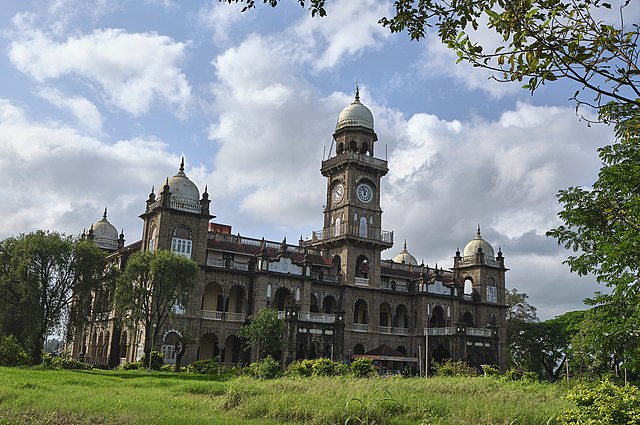


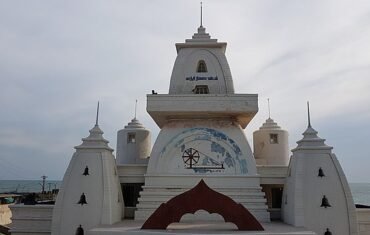


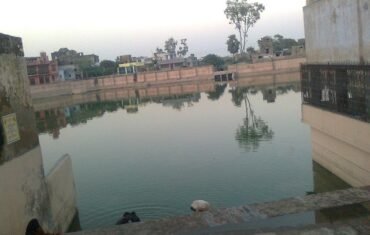
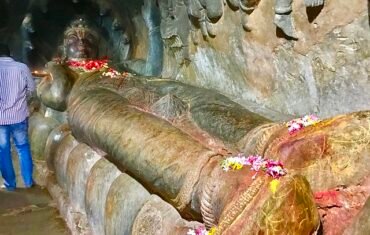



Comments are closed.